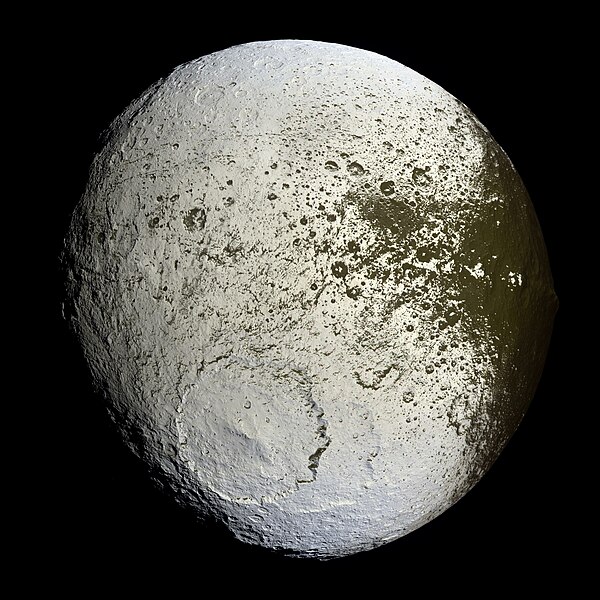Bestand:Iapetus as seen by the Cassini probe - 20071008.jpg

Afbeelding in hogere resolutie (4.032 × 4.032 pixels, bestandsgrootte: 6,22 MB, MIME-type: image/jpeg)
Dit bestand is afkomstig van Wikimedia Commons en kan ook in andere projecten gebruikt worden. De bestandsbeschrijvingspagina wordt hieronder weergegeven.
|

|
Deze afbeelding is geselecteerd als afbeelding van de dag op 27 december 2007. De afbeelding heeft de volgende beschrijving: Andere talen:
Magyar: A Iapetus, a Szaturnusz egyik holdja, a Cassini űrszonda felvételén hamis színezéssel (NASA/JPL/Space Science Institute) |

|
This image was selected as picture of the day on Vietnamese Wikipedia.
|
Beschrijving
| BeschrijvingIapetus as seen by the Cassini probe - 20071008.jpg |
Iapetus as seen by the Cassini probe. |
| Datum | |
| Bron | PIA08384: The Other Side of Iapetus |
| Auteur | NASA / JPL / Space Science Institute |
| Toestemming (Hergebruik van dit bestand) |
PD |
Deze afbeelding of video is gecatalogiseerd door Jet Propulsion Laboratory van de Verenigde Staten National Aeronautics and Space Administration (NASA)onder Foto ID: PIA08384.Deze banner zegt niets over de auteursrechten die van toepassing zijn. Een normale auteursrechten-tag is nodig. Zie Commons:Licensing voor meer informatie. Andere talen:
العربية ∙ беларуская (тарашкевіца) ∙ български ∙ català ∙ čeština ∙ dansk ∙ Deutsch ∙ English ∙ español ∙ فارسی ∙ français ∙ galego ∙ magyar ∙ հայերեն ∙ Bahasa Indonesia ∙ italiano ∙ 日本語 ∙ македонски ∙ മലയാളം ∙ Nederlands ∙ polski ∙ português ∙ русский ∙ sicilianu ∙ slovenščina ∙ Türkçe ∙ українська ∙ 简体中文 ∙ 繁體中文 ∙ +/− |
Licentie
| Public domainPublic domainfalsefalse |
| Dit bestand bevindt zich in het publiek domein, omdat het gemaakt is door de NASA. In de reproductierichtlijnen van de NASA staat dat "NASA-materiaal niet beschermd wordt door auteursrecht, tenzij anders vermeld". |  | |
 |
Waarschuwingen:
|
Bijschriften
Items getoond in dit bestand
beeldt af
8 okt 2007
image/jpeg
Bestandsgeschiedenis
Klik op een datum/tijd om het bestand te zien zoals het destijds was.
| Datum/tijd | Miniatuur | Afmetingen | Gebruiker | Opmerking | |
|---|---|---|---|---|---|
| huidige versie | 12 dec 2018 19:07 |  | 4.032 × 4.032 (6,22 MB) | Kesäperuna | 100% JPEG quality from full quality TIFF, slightly cropped to be more centered. |
Bestandsgebruik
Geen enkele pagina gebruikt dit bestand.
